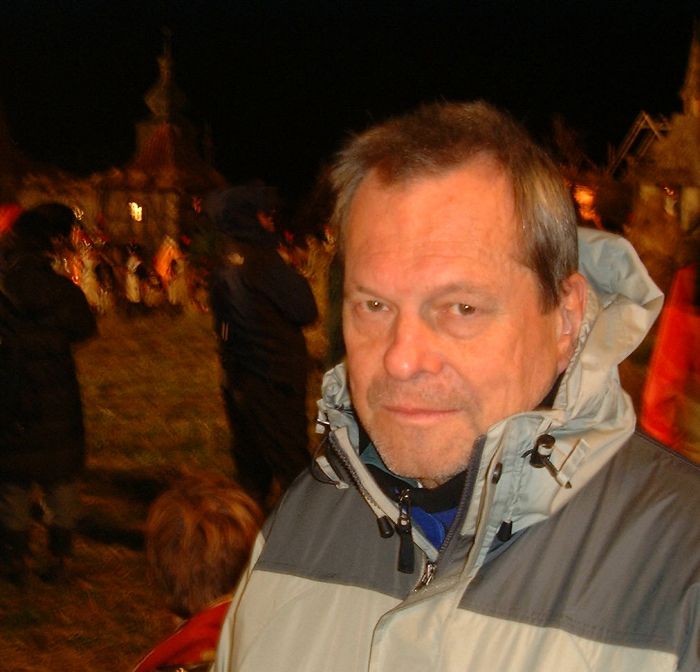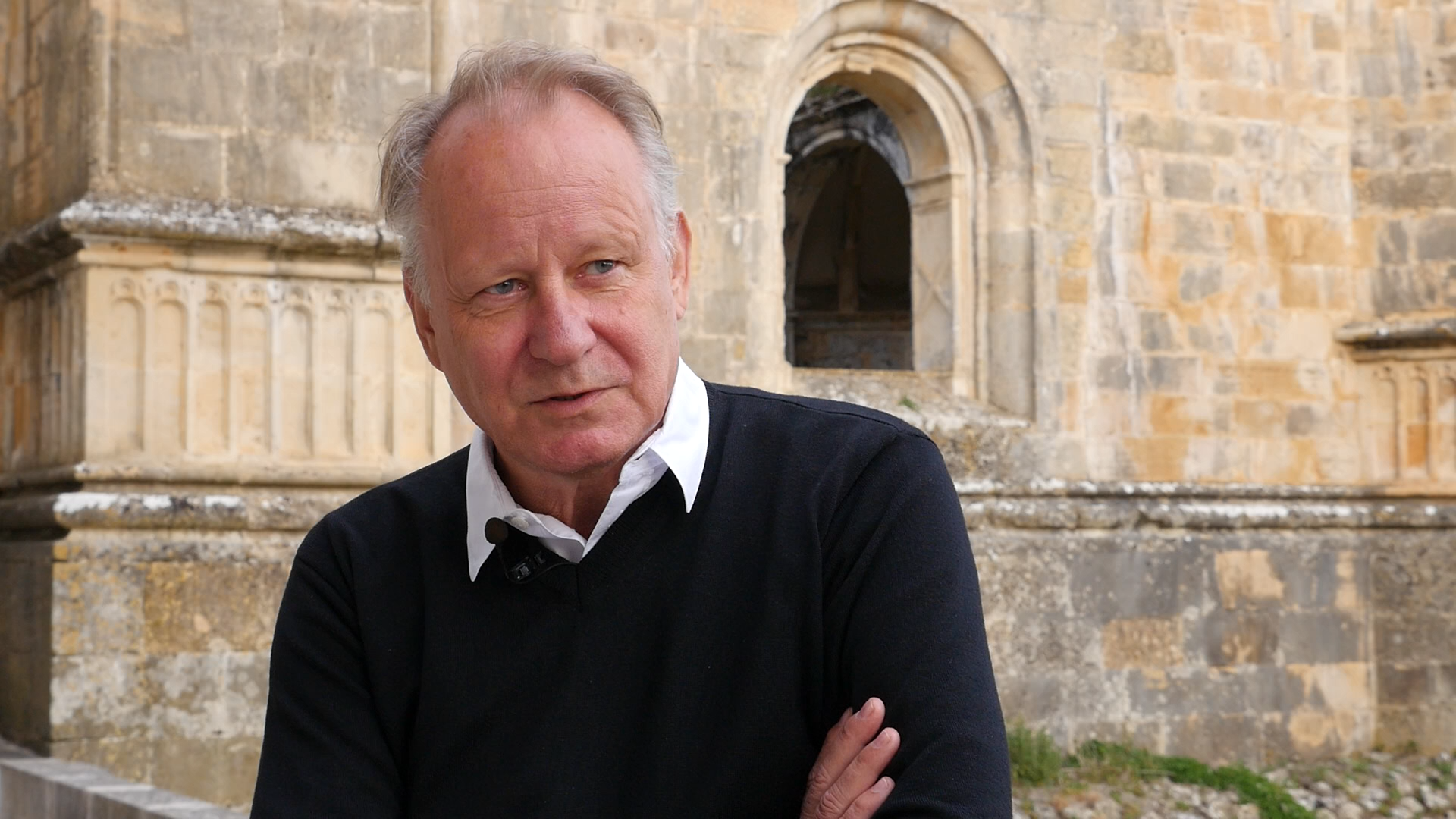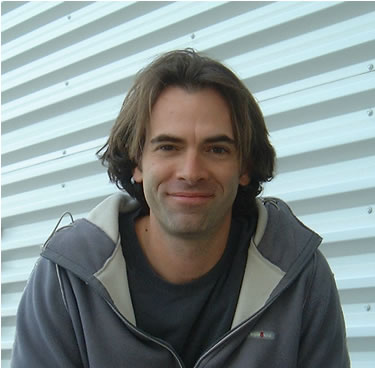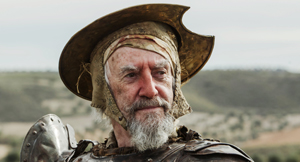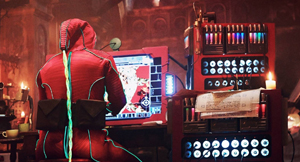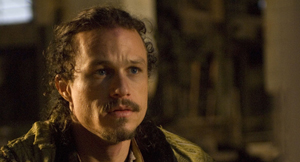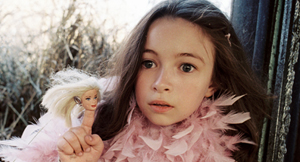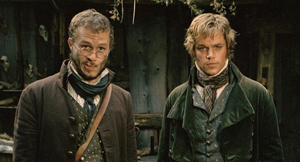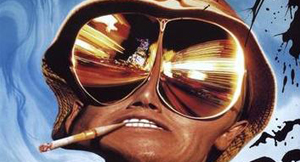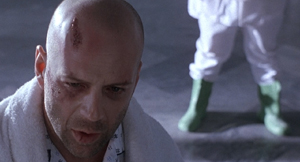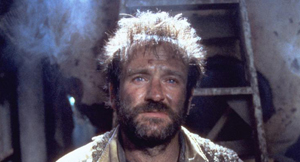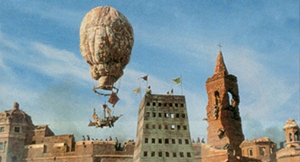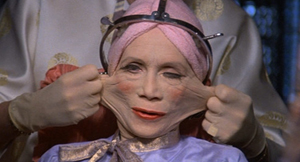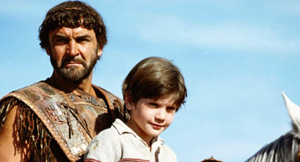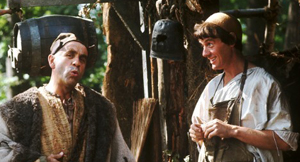In September 2017, Terry Gilliam was working in London on the postproduction of The Man Who Killed Don Quixote. He had just completed a “Friends and Family” cut that was due to be screened that evening. Many effects shots and the soundtrack remained incomplete.
I had visited the Quixote shoot at the Convent of Christ in Tomar, Portugal, in March earlier that year. I was able to conduct several interviews – including this on-set discussion with Gilliam prior to a night shoot. A few hours after that interview, I fell down some steps within the dark convent, and broke three bones in my left foot. After my injury I was unable to walk and a trip to a local hospital was necessary to put my foot in plaster.
I was responsible for writing the film’s production notes, and my requirements for this document guided my questions. By September I was able to walk again and I visited the postproduction HQ, where I found Gilliam in good spirits despite the exhaustion of the shoot and his recent health problems. During the interview we were briefly interrupted by renowned editor Walter Murch who was working on Coup 53 in an office next to where Terry and I were sat.
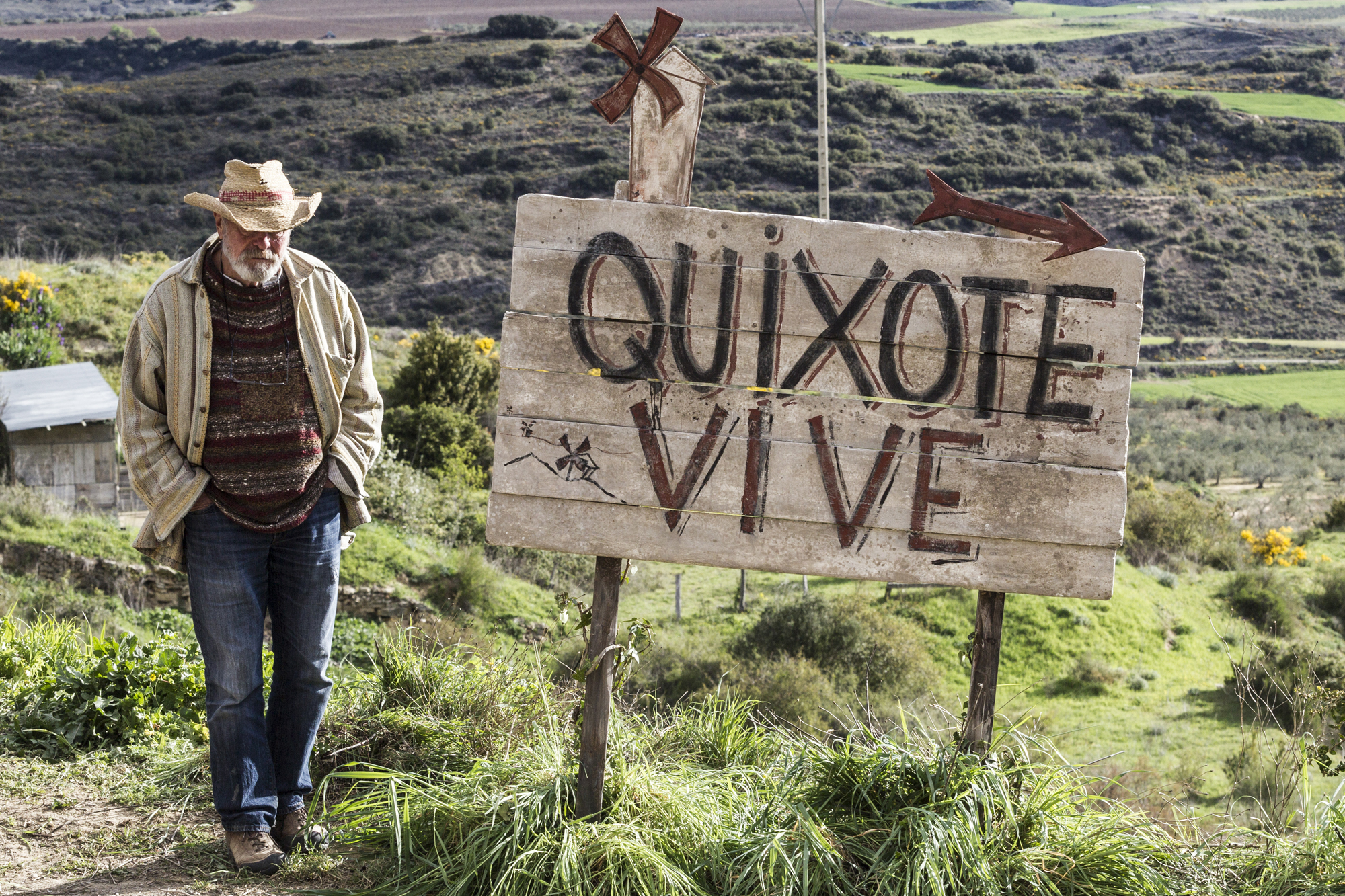
Phil Stubbs: How do you feel about the project at this stage?
Terry Gilliam: Well, sadly, frighteningly, worryingly, I’m beginning to think it’s a very good film. This is scary, because it’s been too long a project and I’ve tried to maintain some kind of objectivity. But I think we’ve made a good one. I really don’t feel comfortable feeling that.
You don’t trust your own taste?
No. It’s corrupted by years of wanting to do it. The thing is the film is a different film than I set out to make 20+ years ago. It’s changed a lot, it’s become less flamboyant, less Gilliam? I don’t know. It’s more about the relationships between Toby and Quixote, and Toby and Angelica. It’s character-driven now. And in that sense it’s really different to some degree. We pulled out a lot of the exotica. In fact the scene in the ruined farmhouse inn, which is a really big scene in the original script, which I’ve been holding on for all these years, I just cut it out of the film. The sequence with Sergi López and Rossy de Palma.
Do we see the farmhouse at all?
In the distance
Why did it have to go?
Because when we first looked at the film, the first sit down with Tony Grisoni, Ray Cooper, Amy, myself, Lesley Walker, it was just clear that when the film starts off, we find ourselves really intrigued/ interested in a sense with the young Toby, and the young Angelica – before ten years elapsed. Things have changed in their life and you really want to get back to those people and the farmhouse inn is a completely different world.
It was also me trying to hold onto another subtheme which is about Islam and terrorism. We set up several things about terrorists and Toby showing a video from ISIS saying that these guys are willing to die for something, their belief. He no longer has belief in anything that he does. But then later Quixote amongst the ruins talking about the wonderful world it was, the Islamic world in the 15th 16th century. When the Moors controlled Spain. The Alhambra and all that. Quixote loves it all, so we always try to show two sides to this place. Some of that is still in there, but a lot is gone, and the inn was very much about that, it was about religion and I just let that go.
Later in postproduction, at the last minute, Gilliam decided to put the Sergi López/Rossy de Palma scene back into the picture.
In the script, do you feel that Toby is responsible for what happens to Javier and Angelica? He feels guilt, but is he responsible for it?
[IRONICALLY] Filmmakers are responsible for everything. All the evil in the world.
The fact that he does feel responsible is interesting because there’s some decency inside of this guy who’s become so hollowed out with success in a sense. This is the autobiographical part of the film. As we come into a community as filmmakers take it over, excite people, lead them down the garden path of their dreams, and then we leave, and we don’t give a shit. We never look back.
And people like me have to deal with broken bones
It’s their problem, but we were the ones who created it by arriving. Yes, we take no prisoners, even you Phil.
Adam Driver – tell me what it was he did particularly well?
Adam is an extraordinary actor, I think. When making the film, I think he is a great re-actor. So you throw Stellan Skarsgård at him, and Jonathan Pryce, and it’s his reaction to them which is so interesting. And his timing is brilliant. When I met Adam I really liked him. He’s different to most actors – there was something that wasn’t actor-ish about him. There was a genuine, interesting character. That fact that when 9/11 occurs, he goes and joins the Marines, to go and fight for his country. I found him intriguing, he surprised me every day by how he said a line, how he ad-libbed things, his ad-libbing was very good. It came from a place that I didn’t totally understand, and I liked it.
Adam at the end of each day seemed depressed, angry with himself for not achieving whatever it was he was hoping to achieve. But I love this guy, when I see him onscreen there’s intelligence, there’s warmth. He’s not afraid of being an asshole – that’s a great thing about the actor. His ego is not involved.
He just gives himself up totally to the character. He’s saying fuck all the way through the film, which wasn’t in the script, because I think he was becoming me. Because that’s the way I speak, he started talking like I do. And when it comes to being romantic, he’s a great romantic. There’s a scene when he meets Angelica the second time, she’s older and him just watching her as she speaks. He’s in love. It’s so simple he’s doing nothing. That’s what’s interesting about it he’s not doing anything flamboyant crazy he’s just there… He doesn’t look like anybody else – he’s very chameleon-like in a strange way. He can be quite homely one minute, and absolutely beautiful the next. That’s an amazing quality.
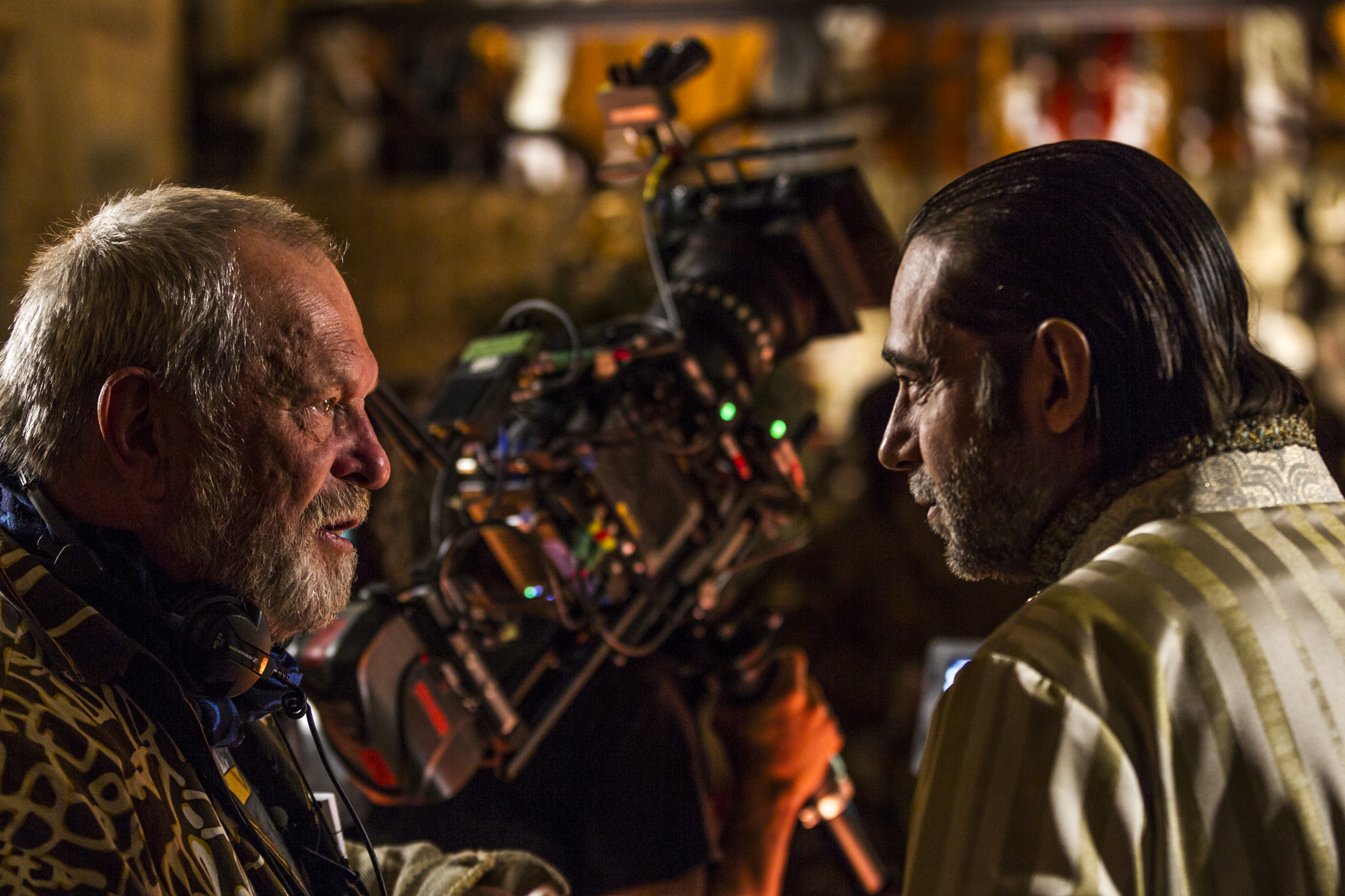
Can you tell me a few things about Jordi Mollà?
Jordi Mollà, I love Jordi Mollà. Years ago when he made a film with Johnny Depp, Blow, I think I met him around that point. I liked him I was intrigued by him. He’s dangerous and at the same time an incredibly sweet human being. And I always wanted to work with him. So when I was in the situation where I needed Spanish actors to get the Spanish money, Jordi was one of the first – well, I’ll have him! And he was interested, and he is playing Alexei. Alexei is an absolute monster.
There is one scene when Adam turns up and we’ve got Angelica there who is Alexei’s girlfriend, and now current concubine basically. There’s the three of them, it’s a terrifying scene because he is so dangerous, he has eyes that are shark’s eyes when he wants to use them that way. He found those days working were really upsetting him to play somebody so horrible, and monstrous. He’s absolutely terrifying, the intensity, the focus.
That’s what’s been interesting about most of the actors in this, their focus is fantastic. Whether it’s Angelica, or whether it’s Stellan Skarsgård. Their focus is right there. If I can pride myself with anything, it’s casting well because these people all have it. And you see them working together and they’re fire. They’re fantastic.
How about Óscar Jaenada?
Óscar Jaenada is great. The gypsy is a rather enigmatic character. Not much described about, he is just there. Basically he’s the Deus Ex Machina of the piece, so his name is Díaz Ex Machina. Óscar, again, put in a situation where I need to work with Spanish actors, the requirement. I didn’t know anything about Óscar, but they showed me his film that he made where he plays Cantinflas, the great Mexican comic. And he doesn’t look anything like Cantinflas but when you watch the film, he’s Cantinflas. It’s a brilliant performance and he was interested. The idea when I see someone being brilliant, I want them, and the fact they are happy enough to come and play with me is brilliant.
And Jason Watkins?
Another brilliant one. We had Jason down very early as the character of Rupert. Because Rupert is Toby’s agent, he’s probably gay, he’s got all sorts of things going on. He looks after Toby, he’s almost like a guru to him. He knows Toby is the golden goose, keeps laying golden eggs for him. Rupert wants to get to Hollywood, so he’s got all those qualities. And Jason is a wonderful actor and he came in, it only took a few days, maybe a week. Because he was: what’s this character, how do I deal with it? And then one day he’s got it and there he was. He’s brilliant, his timing is phenomenal. He can handle a scene even though he’s just a small part of the scene. He has a way of keeping your attention, he’s funny as hell. What else can I say about him, he’s brilliant.
What’s interesting about the film, whether it’s been patience or the passage of time or whatever, we’ve ended up with maybe the best people we could get, for all these parts. Jason wasn’t available when we were planning to shoot with Paulo Branco. And with the delay he was available, so we ended up getting the right people.
How much construction or dressing was required for Almonacid, the castle.
Life was very easy for us. All we had to do was bring in a tent, a beautiful tent that Eduardo [Hidalgo] made. That was basically it. That location was one of the first locations I ever saw when I was planning to make this movie, somewhere around 89/90. One of those beautiful places where you’ve got those ruined walls that are interesting – a mixture of Christian and Moorish architecture so it fits in the world we’re trying to create. It was so strange because at one point when Tornasol took over the movie, they were showing me everywhere but Almonacid. I said no. It was a waste of time. I like looking at castles / ruined castles but it was always this place, and we got it.
In the movie, there’s a windmill that sits within the modern turbines.
We start the film with this commercial. Where the main character and the commercial Don Quixote, we need a windmill. Years ago, the turbines became a big thing in my mind. Because when I first was looking for locations, I remember driving on the motorway from Madrid towards Avila. And seeing these beautiful hills. Mountains they were, mountains. And a few years later, another attempt to make the film, I was driving, and suddenly those mountains were no longer great mountains they were hills. Because they now had turbines on them. And the turbines completely destroyed the scale of what we were looking at. So it was one of the first turbine places I went to. There it was – Villacastín, on this ridge.
The idea was always that the commercial was about this power company. And the idea for me was to put an old windmill up amongst the modern wind turbines. You don’t see at first there are modern turbines, but it’s a commercial using both things. It’s wonderfully bizarre, to see the windmills that used to cover Spain with the new windmills that cover Spain.
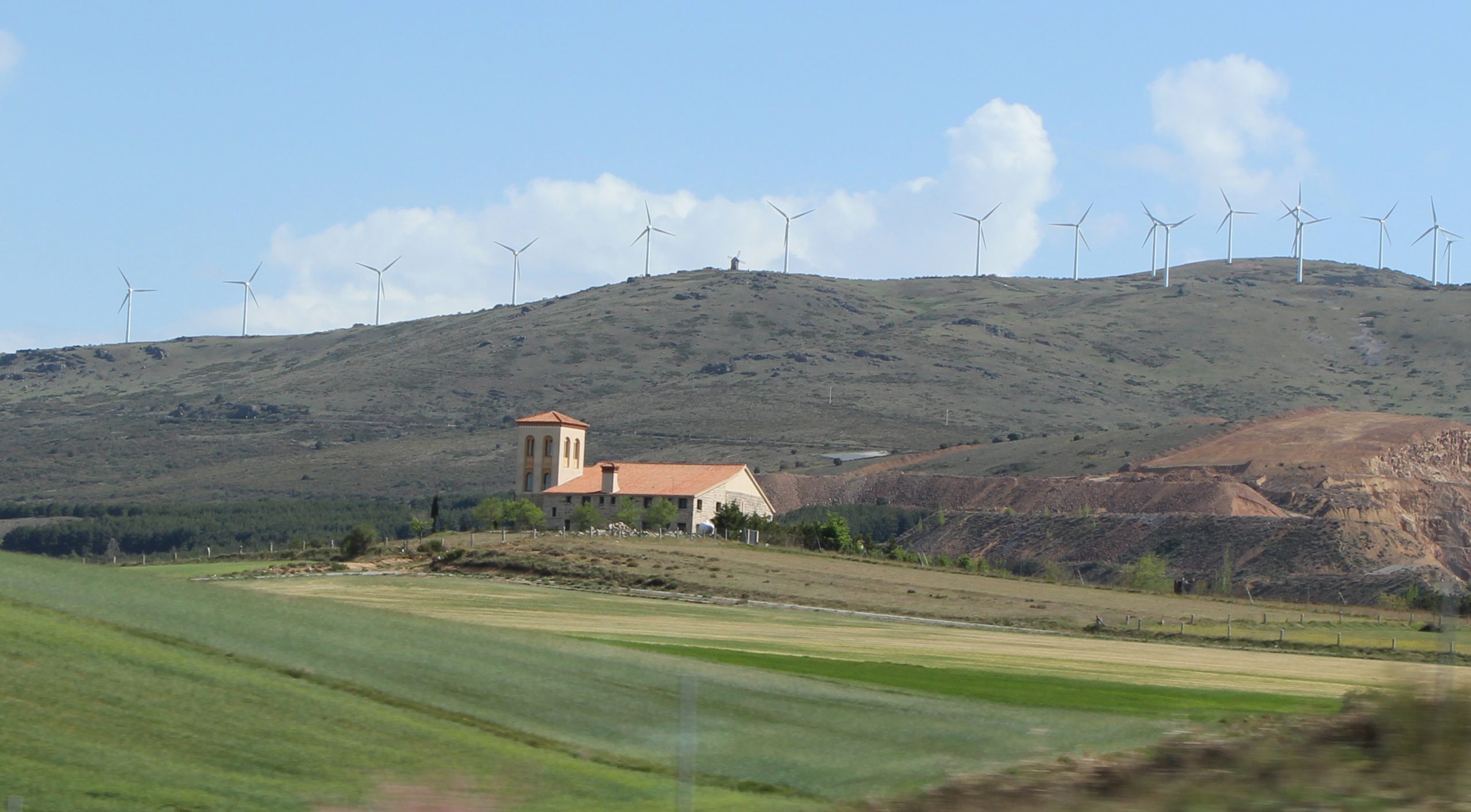
On my way to Tomar I actually went past Villacastín on the motorway, and saw the old windmill between the turbines. I was wondering whether any commuters driving along thought to themselves: has that old windmill been there all along?
Windmills have been put in places that have wind. So you have modern ones in the same places, but there probably was never an old windmill in that position.
Was it difficult to build the windmill there?
We had permission but of course everything went wrong. We had a deal with the company that had the turbine, however they were leasing the property from a man down the hill who’s got a quarry. So we had to get permission from the man with the quarry. And he wanted money.
We did all that so now we’ve got the turbine location. The only thing we wanted to get rid of was a wire fence that separated the part of the properties with the turbines with another part of the property that was the man’s – where horses and bulls were grazing. And just a couple of days before we were going to shoot there, having built the windmill, we just needed to get that little wire fence down, but the man’s friend had been gored by a bull. So they wouldn’t let us take the fence down. It didn’t make any difference in the end: it was just one more thing just waiting to snag us.
Moving to costumes, Lena Mossum mentioned a book you gave her about ferias & fiestas. Could you tell me a bit about that, the inspiration it gave you?
I’m obsessed with Spanish fiestas, the idea of what they do. Whether it’s bull running, or whether it’s Las Fallas, Valencia burning these great tableau figures. And so I had this book for years, from the beginning, and it’s always fascinated me the costumes, the world that is represented by all these different fiestas. So it’s been central to all my attempts to make this film. As far as costume design, the things that go on in these fiestas. So yes, that was the book I gave to Lena, that is what we are working from. You can’t invent some of the things that are so outrageous.
Could you tell me about the costume for the Knight of the Mirrors?
The Knight of the Mirrors had to be a reflective kind of knight. Now we could put him in armour, and stick something on to cause reflections. In the end we decided… it must have been Lena’s idea but it could have been Eduardo’s, to cut up old CDs and use them as reflecting surfaces, to stick on the knight’s armour. In the end we went for more of a leather tabard rather than a lot of armour, and then covered it with – at first it was a regular pattern of broken pieces of reflective material. Then it got a bit more exotic as we went on.
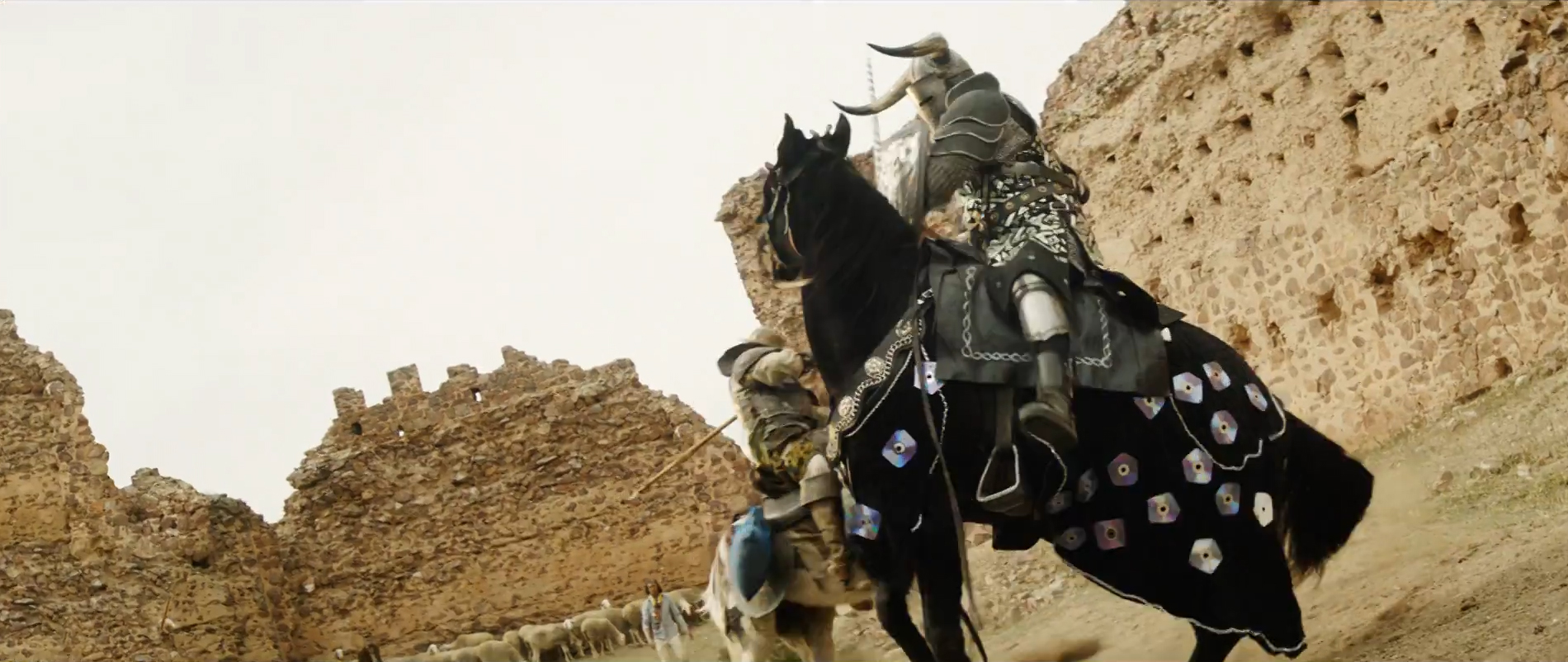
The idea of the costume was it was supposed to be made by Raul, the father of Angelica, who’s the man at the bar to put on a costume that would lure Quixote back into their world so they could take him home. It had to be a mixture of… at one point it was going to be bottle caps. Coke bottle caps, reflective things we can stick on this tabard.
We put on knee protectors like when you’re tiling a floor. The helmet, she took a motorcycle helmet, we stuck a panel on the front so it looked like a visor, in the end you’ve got something that looks like a medieval knight, it’s incredibly reflective, and it’s really like a mirror ball at a disco. It’s what he should look like in a sense, and he does in his own way. This world where when you first see it, looks extraordinary, fantastic, amazing, and then when everything crashes and you see closely what it is, you realise this is what they’ve been doing. It’s all fakery trying to lure Quixote back again.
Quixote’s costume was from the first attempt!
We had a very short prep time, and it wasn’t going particularly well, with the limited budget we were with. There were all sorts of plans to do it this way and that, but all that takes time. And usually it takes money, which Lena was really pressed because she had the rest of the film to get costumes sorted out.
And at one point I said we do not have enough time to do Quixote’s costumes properly. And Nicola Pecorini picked up the phone and called Carlo Poggioli who had been Gabriella’s assistant when we were first making the film. And Carlo was literally opening a box with Quixote’s costume in it because he was going to use it in an opera he was working on. The timing was unbelievable… this is when you get mystical. We then called Gabriella, and she was happy that it would be finally used in the film. I said – no more discussion, we should just get it, and it solved the problem, and the idea of using the original costume was too good to say no to. So that costume has been with us since 2000, and with Lena doing some adjustments, it fitted Jonathan perfectly.
Which character had your favourite make-up and hair?
I always thought with Angelica, since we’ve got to make her ten years younger, that since she’s dark-haired anyway, I though light hair would make her look younger. And that was what was interesting when we did it, Sylvie and the hairdresser came in and they put a dark wig on her for the young Angelica, they put a blonde wig on Joana for the old one. I said What? but it worked. It was a complete flip-flop on what I thought would work, and somehow the blonde made her look older.
The thing that I’m most happy about make-up on this film is the fact that both Angelica/Joana and Adam have a span of 10 years – and it works. It’s brilliant by just combing Adam’s hair in a different way, doing a few little bits, he’s suddenly 10 years younger. Joana was perfect – she was 25 years old, so she was right for the older one but as the younger Angelica, so we put braces on as well, and this dark wig. We took Joana’s hair and bleached it, put a lot of highlights in it so became quite blonde. So she had to wear a wig to be dark haired like she normally is. It’s the subtle stuff.
The stuff at the party, the ballroom, they did all sorts of incredible hairstyles. They were quite amazing.
Did you leave them to it?
Yes, just let them get on with it, because they were coming up with really good interesting ideas. So I just stayed out of that, let them play and have a good time.
I loved the candy floss hair.
They were outrageous hairstyles but the thing I like the most is the make-up/hair for Adam and Joana to do the two ages, because I didn’t think it was going to work, but it does.
Moving on to the cinematography. Why digital and not film?
Financial. Purely financial, nothing more. It was cheaper. Nicola will probably argue against that but nobody’s proved that it would be other, that’s why we ended up doing it. I’d rather work on film personally.
There’s been a few smudges, have they been caused by the digital sensors or the lenses – have you got to the bottom of that?
I don’t know what caused the smudges. Whether it was the lens… It’s proving to be painful, it’s going to cost money.
In hindsight, what has been the result of digital?
We’re seeing all these smudges, we’ve got to get rid of them. We’re also getting aberration on the wide angle lenses. Some of these will have to be effects shots. Nicola says when you’ve got the foreground dark and the distance very light, suddenly you start getting rainbow effects around the edge of the dark bit. I don’t know if that is the lenses. The problem with digital for me is the contrast ratio. It’s as simple as that. When we clip the light end, there’s no information. It’s gone, it’s just pure nothing. Whereas with film there’ll be some detail still in there to play with.
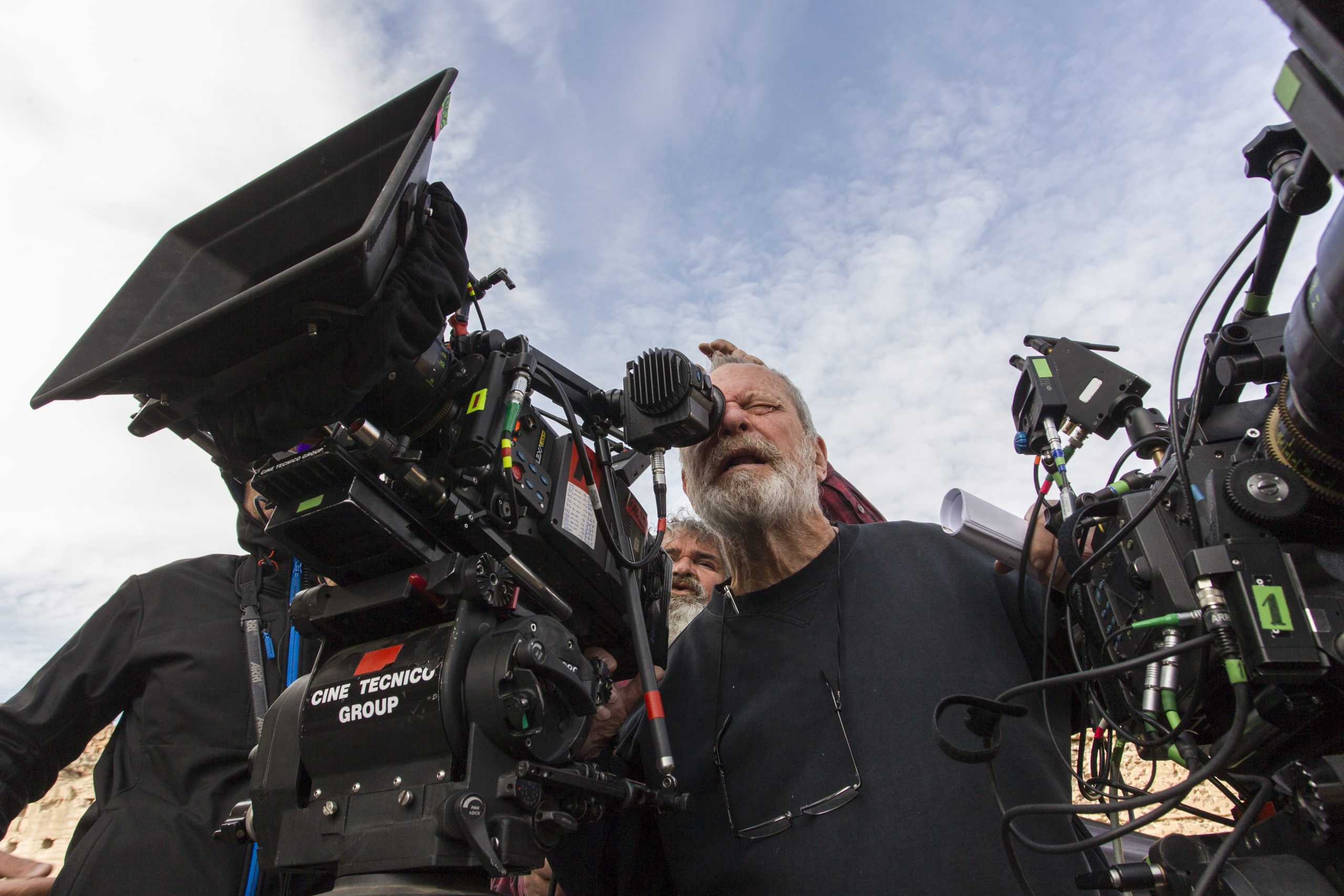
The lenses
I hate them. Fucking anamorphic lenses.
They were the lenses used for Apocalypse Now
Fuck I don’t care. All I know is that they are very, very big and they are very heavy. And to change a lens takes five minutes because you’ve got to change the matte box. You’ve got to change all this stuff. I hate them.
Have you anything good to say about them for the production notes?
No. Nicola says: but the image is so beautiful. Well fuck it, it’s a pain in the ass. I just want to be able to shoot faster. And it slowed the shooting down. And the crew is humping very heavy lenses up mountain sides.
How extreme were the wide angles?
The wide angles were not as extreme as the spherical lenses we’ve used in the past. So it’s not as wide-angled a film as normally you’d expect from people like me. We were shooting with two cameras a lot – the only way we could move quickly enough to get through the stuff.
And to what extent did you storyboard and work out every shot in advance with Nicola?
We just storyboarded the effects scenes basically, that’s all. We don’t waste time storyboarding. We talk about what we’re doing, we work what we’re doing. I just wing it now. For better or worse, and sometimes it is worse because I don’t even read the script half the time now, because I know what it is. It’s only after we’ve shot a whole scene when I realise: why didn’t I read the script, I would have shot it better.
Any interesting stories about each of the locations you used? Let’s start with Oreja.
The whole point about Oreja was that we were using one location for four different places. The horrible thing about the path up the side of the hill. I thought: that’s great, we checked it out – the horse and the donkey could do it – the place the dead mule would be lying. But it was a nightmare to work because everything had to be carried up by hand. There was no place to put the stupid anamorphic lens boxes, it was really rough for everybody. It was a hard one. The actual castle itself was fine where we shot. Then we shot some of the exterior of the farm, that was OK. Where we built the windmill, no problem, there it was good. We planned all of that when they ride up before they get to the windmill. All of that was working because we’d actually done our work because we were going to start there.
The thing that was the nightmare was the lea side of the hill, as it’s known, because nobody could move trying to get up past things to get all the gear up there was really hard. But it works out, it’s a good location and then at the last moment I found another aspect of it that we could use because we were running out of time. I walked to an area I hadn’t been at, just out of curiosity. It was at lunchtime, it was trying to get away from everything. A scene that was supposed to be done elsewhere, I said were doing it now, we got to do this scene right now when they ride away from the waterfall, chasing Angelica. The nightmare of that was we hadn’t gone to the business of getting mud on Toby’s face, at the exterior of the waterfall, so hadn’t been tested. I said I don’t give a shit. So just slap some stuff on his face. In the make-up department, everybody’s going crazy. So we’re shooting. The sun’s good, we can do it right now while we’re waiting for something else. We got the shot, it’s in the movie.
The Monasterio de Piedra
That’s the most wonderful place, but a total nightmare. Inside the waterfall, in the cavern behind the waterfall, it is cold, it is wet. It’s slippery, it is dangerous. You can’t see where you’re walking half the time. Everything was hard. But it worked, we got it. We had to build a platform in there. But it worked. Terrifying. The good thing was that Joana didn’t get sick. Because she was freezing. First day of shooting. She’s there in a little slip while the water’s pouring down around her. She was great she had to climb down the rocks looking good. And they were so slippery and dangerous. She did all this stuff fantastically well. We had this big tub full of hot water to dump her in, in between – because she had to stay wet the whole time.
I love Piedra. We got the exterior shots with only minor problems. We had to build some rocks, we had to make some space for the horses, and basically it all went fine. Nothing went wrong there. We had to clear some greenery at the last moment because it hadn’t been done. And then we used the ruined church where we had to build in to make it a ruin. That was interesting, it was nicely done. There was a shot which was the most complicated shot – which is no longer in the movie – where Toby had to be singing a hymn and floating above the earth as he floated through the portal of what was supposed to be heaven’s gate. But it’s not in the movie, after all that!
In Tomar, inside the chapel, you lost a lot of time. What was causing those problems?
You know, I can’t remember. I literally went blank in there. Because there was so much to do, and we didn’t even do what I wanted to do. The charola is utterly beautiful, but it takes time to light. But when we had the rocking horse, we had all those people, on the day unfortunately rather than planning it well enough in advance, I wanted to get a crane in there so we could shoot Quixote when he’s flying to the moon, we’d sweep through. It just didn’t happen, we ran out of time. There were all these extras but the day just kind of fell apart. I can’t put my finger on exactly why. I’m ready to blame a lot of people. But I won’t.
Did you shoot an extra day in Tomar?
I can’t remember. I was not well around those days. The days in Tomar – I just loved that place. I’d such a lot of ideas, what to do there. You could shoot the entire film at Tomar! And I was just grabbing shots to get through it, and then we were doing the burning and the rain. We lost a lot of time there. But I wasn’t really functioning very well. The whole scene when he arrives, sees Angelica and we see Santa Cathartica, that was the scene where I didn’t read the script. I had images in my head, and an idea of what I wanted to do. But if I’d read the script I would have shot it in a different way.
We’ve made it work, but it’s not as good as I wanted it, but I was actually, I realise now I was not very healthy during that time, I was in real trouble. It was the big moment that I should have been on form, but I was struggling.
Horses. This film has horses.
Father and son, Ricardo Cruz senior and junior were brilliant. These horses were fantastic. And I was scared to death. Horses take time. Jonathan’s got to ride, Adam’s got to ride. Donkeys are a little more problematic. But the horses were brilliant.
We had a couple of horses to play Rocinante. We had Aitana Fuentes doing make-up on Rocinante every day. She was great at painting Rocinante every day. So his eyes were dark and drippy, snot coming out of his nose, sores, she painted the ribs, shadows of the ribs and when you see it on film, it looks fantastic, and he’s really bony. The sores are from when he was used as a carthorse. All of this stuff was absolutely brilliant work. I can’t say anything but wonderful things about the horses.
I will say something about Jonathan. He had a bad knee, he also had a very bad ankle so when we first got him to Spain, physically he had many, many problems. We first put him on a horse, it was like a kid being led around. And we were all being very careful because Jonathan was very worried. We were all worried, we had to keep him healthy for this whole thing. He was led around and it went on and on and on… It got better, he was riding the horse, he was moving around OK.
On the day he has to charge the windmill. I said: Jon – you’ve got to ride Rocinante charging up the hill, he’s got to do a sharp left hand turn, and head towards the windmill. He said, I don’t think I can get on this horse. I just don’t trust my knees. So we shoot it with Bisbal, Jonathan’s stunt double. And the day goes by and we have the shots. Bisbal’s a pretty good double, and I thought shot of him riding up the hill and turning past camera it might work, but nah, I could see it’s a stunt double.
I said to Jon, do you think you could just ride a little bit, through the turn, and we could get you doing the turn? This will be fantastic. We’d reached the end of the day and he said, alright, I’ll give it a go. Just that bit? Yeah. So there’s the horse, we started him down the hill. And action. Jonathan kicks it, he goes full gallop. Charging up the hill, lance in hand. Takes that corner brilliantly and heads towards the windmill. The whole crew stood up and applauded. It was a great day. Jonathan knows how to do this kind of stuff, he’s a theatre actor. He waited until the last moment and just blew everybody away.
How funny do you think the film is?
I think it’s very funny, it’s just Jonathan in particular has made it very funny. And he just squeezed out laughs on lines that wouldn’t normally be funny. He ad-libbed a lot, and Adam started ad-libbing and the combination is really good. It’s very funny, but I wouldn’t say it’s a comedy. That’s what’s interesting about it. It’s a romantic film more than anything. The adventures are pretty good, there’s action, we keep it lively, and there’s laughs all the way through it. Not big belly laughs, I don’t think. There are some belly laughs I’d say, but the rest you’re enjoying it, you’re smiling.
The thing that saves the film more than anything are the actors. For me, what makes the film work is the actors, that’s for me the most pleasurable part of making it. In a strange way all the technical, the effects stuff, stuff I know how to do… I can do all of that, but it doesn’t surprise me. The actors always surprise me, and that’s great!


